Uitonrinne wooden house milieu
In the centre of Sulkava, the area between Lake Saimaa and Mikkolantie is classified as a nationally significant environment/tourist attraction. There are several gambrel-roofed buildings in the area, and traditional courtyards. This is also where the important sites for tourism are: the rowing stadium, boating centre Kulkemus, the harbour, the tourist information at cafeteria shop Alina, as well as Kästyöpuoti, a shop open in the summer and selling local handicrafts.
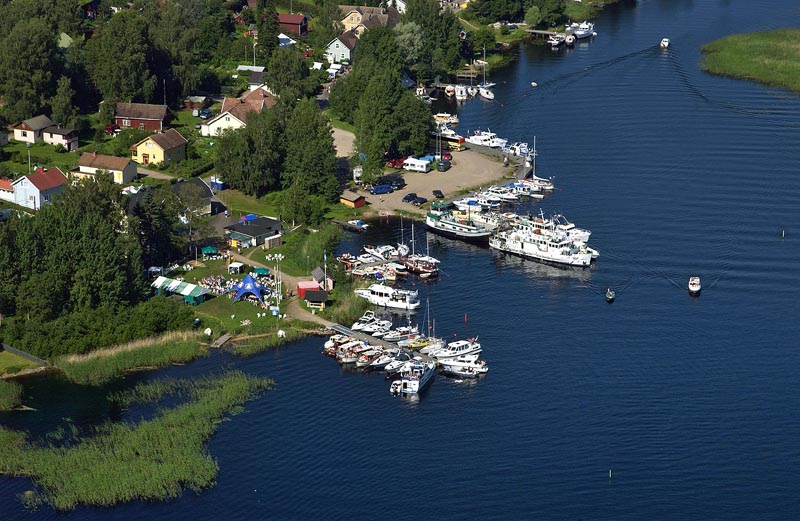
Linnavuori, Linnavuorentie 306
The Pisamalahti hill fort is one of the most valuable ancient forts in Finland. The remains of a defence rampart from the 12th century can be found on top of the hill fort. The hill fort rises to about 55 metres above Lake Enonvesi.
There is an excursion harbour, a barbecue spot and a toilet in the area.
A map link to Linnavuori here.
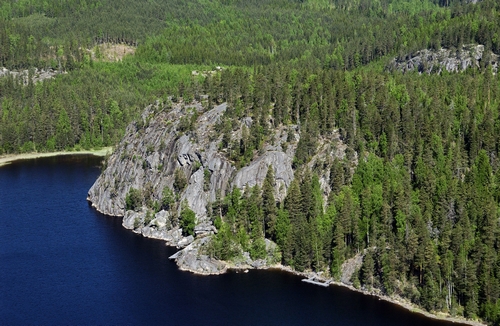
Vilkaharju
Vilkaharju is an approximately four kilometres long ridge area, regionally significant for its scenery, geology, and forests. It is surrounded by the waterways of Lake Saimaa, and located about five kilometres from Sulkava towards Imatra.
It has been a nature conservation area since 1978.
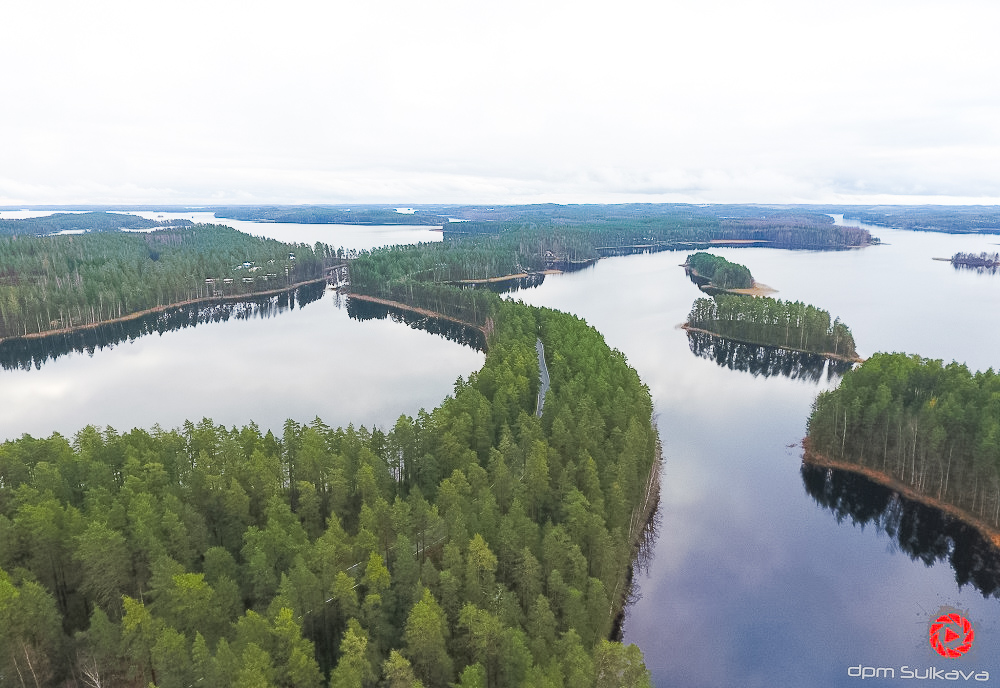
Sulkava Church, Kirkkotie 1
The wooden double cruciform church was built in 1822 based on the design by the state architect Bass. The bell tower dates back to 1770, and it was designed by Petrell. There is a burial chamber in the churchyard, built from the beams of the demounted old church, to protect the tombs of the Pistolekors family.
The church is open every day from the 1st of June to the 31st of August, 10 am – 6 pm.
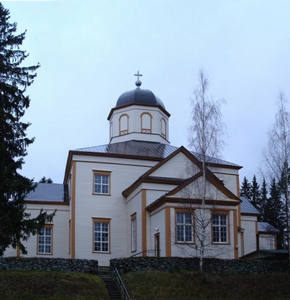
Lohikoski Church, Kappelitie 12
This so-called long church with a gable tower dates back to the 1930s. The church was designed by Ilmari Virkkala.
The church is open from the 1st of June to the 31st of August, Mon–Thu 9 am – 3 pm and Fri 8 am – 1 pm. Tel. +358 (0)15 673 267.
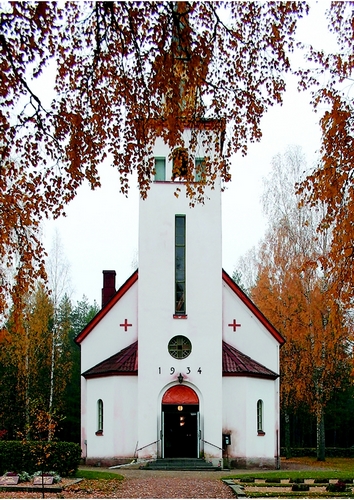
Telataipale canal, Lohilahdentie 1137
One of the so-called Suvorov canals built in the 1790s. The other canals are Kukonkanta in Puumala, and Käyhkää and Kutvele in Ruokolahti. The canals were built at a time when the boundary between Sweden-Finland and Russia crossed the Vekaransalmi inlet. The canals secured the travel from Olavinlinna castle to St. Petersburg.
Telataipaleen canal was renovated in 2007–2008 by the National Board of Antiquities and Historical Monuments.
A map link to Telataipale canal here.
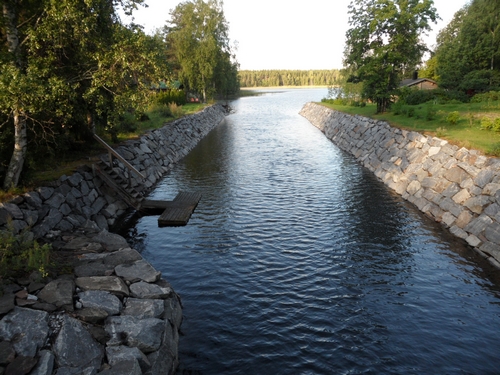
Karjulanmäki Stone Church, Huosiorannantie
A large erratic boulder transported by the glacier during Ice Age. It has since cracked, forming caverns big enough to fit about 20 people in the largest one.
The stone church is 15 meters high at its highest point.
Along the path leading to the stone church, there is an arboretum hosting a memorial forest of foreign tree species planted in the 1930s. The saplings were donated by a local great man, counsellor Hämäläinen. The saplings were planted by the then pupils of the nearby Karjulanmäki school.
A map link to the stone church here.
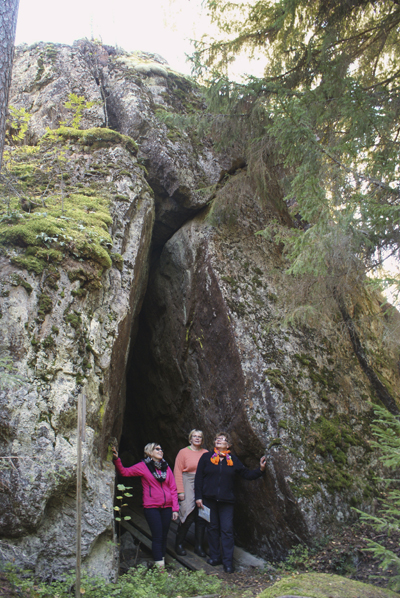
Rauhaniemi Museum Area
The Log-floating Museum, and a chimneyless hut that was transported from Kyrsyänsalo, with a courtyard.
at Vanha lossiranta 2, Sulkava.
Inquiries, tel. +358 (0)44 5275200 or +358 (0)44 4175215.
Read more here.
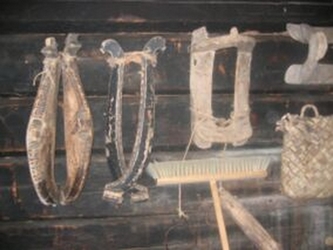
Julunkivi
Julunkivi in Sulkava's Lohikoski, in the conservation area of old forests, is one of the largest erratic boulders in Finland. The height of the boulder is 12.5 metres, and the perimeter is almost 60 metres. Julunkivi is an excellent outdoor destination because of its location by Lake Saimaa, and the fireplace "under" the boulder. The boulder is about 700 metres on foot, on the hiking trail running through the forest.
A map link to Julunkivi here.
Monuments
A monument of bygone generations
As an event related to the 150th jubilee of the church in 1972, stones were brought from all 37 Sulkava villages to the monument erected on the churchyard. The place of the monument on the churchyard had been the location for the churches built in 1653 and 1753.
Memorial stones of Stone Age settlements
There are several prehistoric settlements in the area of Sulkava.
The locations of Stone Age settlements are marked with railing stones recycled from the old parish centre bridge.
The Salpa Line
In Sulkava, the Sarsuinmäki artillery batteries, as well as the Vilkaharju, Vekara, and Telakanava anti-tank obstacles belong to the Salpa Line. The website of the Salpa Line Heritage Society contains information about the Sulkava portion, as well. - The Salpa Line is being developed into a large tourist attraction.
Sarsuinmäki artillery batteries and the museum gun
Hirviniementie
A fort artillery battery of the Salpa Line. The battery was completed in 1940, and at the time was the 30th fort artillery battery in Finland. The gun is a French gun of the make Canet with a 7-metre-long gun barrel
A map link to the artillery battery here..
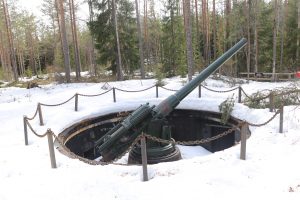
Sairalanmäki military graves
at Sairalanmäentie
A graveyard dating back to the Russian War (1788–90) of Gustav III of Sweden, where the soldiers who fell in the battle of Siikakoski in 1789 were buried. It is believed that there lie 303 soldiers, and one woman and one child.
There is a monument in the area with the text:
"Stop, traveller. Bare your head on behalf of your country. To the memory of the fallen 5/VII - 19/VII 1789."
In addition, in the corner of the graveyard there is a white wooden cross erected by the Sulkava Reserve Officer's Club, with the words: "In memory of the officers fallen in the 1789 battle 18.7.1954"
A map link here. .
The cross for the soldiers of the Elfsborg regiment
at Halttulantie
The memorial cross of the Elfsborg regiment soldiers fallen during the Gustav III wars is located in the Halttula village of Sulkava. Counsellor Kaarlo Hämäläinen erected the grave mound in 1934, together with the villagers of Halttula. On top of the mound the Sulkava Lions Club erected a cross made of copper. The unveiling ceremony of the cross was on the 19th of June, 1966. The following text is engraved on the plaque of the memorial cross:
“GRAVEYARD OF THE ELFSBORG REGIMENT SOLDIERS FALLEN DURING THE GUSTAV III WARS OF 1788-1790. THE GRAVE SITE WAS FOUND, AND THE MONUMENT ESTABLISHED, BY COUNSELLOR KAARLO HÄMÄLÄINEN ALONG WITH THE VILLAGERS IN 1934 / THE CROSS WAS ERECTED BY LIONS CLUB SULKAVA IN 1966.”
A map link here..
In the churchyard of the Sulkava parish there is also a monument in memory of the Elfsborg regiment. The stone has the following epitaph:
“Here lie the soldiers of the Elfsborg regiment, that sacrificed their lives for their homeland in the war of 1788–1790. The monument was erected by the royal Elfsborg regiment in 1936.”
Cenotaph to fallen heroes
A monument to the War of Independence and Civil War, in the parish centre churchyard.
The cenotaph was originally a monument only for the White side victims in the Civil War, with the names of those Sulkava residents who died, as well as an epitaph poem:
"1939–1934
Vaikkakin kaaduitte urhot, te kuolleet ette.
Kalpanne lyö yhä, viel yhä kamppailette.
Puolesta maamme kauniimman huomenruskon,
lastemme kehtojen, isien talven ja uskon.
Annoitte voimaa sydämehen kaikille meille.
Kiitos ja kunnia sankarit, työstänne teille."
In the 1990s, a memorial stone for the Red victims of the Civil War was attached to the cenotaph, with the names of the deceased Reds from Sulkava.
Mark Monument
The message of this monument is to not only pay homage to Finland’s own discontinued money, the Finnish Mark, but to also to honour Finnish labour. The granite stone, brought there by the Ice Age, was found on a field in Kesohiekka, belonging to family Sinkkonen. The monument was created by an artist Mika Minkkinen from Kuopio, the planning was done by the then chairman of the village board, Osmo Sinkkonen, and the Lohilahti village association had it built. It includes a propeller blade of an old tugboat, an anchor, boom drill bits, and a Mark coin masoned on the base. The monument reflects the elements important to the village and the lives of the villagers: labour, water, and water transport. The Mark Monument was revealed on the 27th of July, 2001.
A map link to the monument here..
Sulkava Rowing Race Statue
The Rowing Statue in the Sulkava market square area was revealed on the 4th of July, 2007.
The statue was designed by a Sulkava painter Olavi Uusitalo, and it was sculpted by sculptor Heikki Räsänen.
MONUMENTS
Counsellor Kaarlo Hämäläinen
born 21 Dec 1879, died 13 Aug 1951
The tombstone is in the churchyard of the Sulkava Church. It contains the epitaph:
“TO A RESEARCHER AND FRIEND,
FROM THE SULKAVA MUNICIPALITY”
"TREASURE THE PAST"
Monument to Counsellor Hämäläinen in front of the Sulkava library.
The monument commissioned by the Telataipale Family Society of Hämäläinen from sculptor Heikki Räisänen was revealed on the 13th of August, 2011, precisely 60 years after the death of the Counsellor.
Mikko Torvelainen, Poem Singer
born in1765 in Sulkava, Väätälänmäki, died in 1856
The monument in the Adult Education Centre's courtyard was erected on the 7th of July, 1985, in honour of the Kalevala jubilee year. It has the following poem:
"Miely mehte, kostu korpi,
Miehen mänesen mätelle,
Minun pyyntö päivineini,
Sekä sualis aikoiani,
Suata sualisen jumala,
Esihin yhyttäköni!"